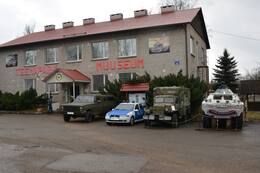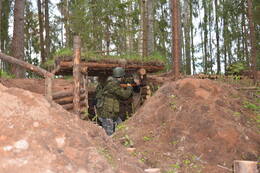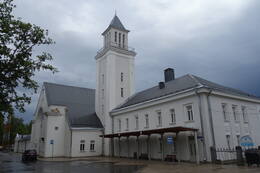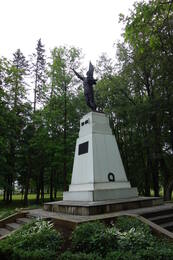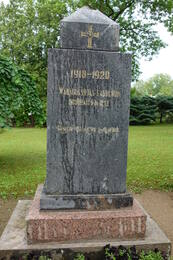Estijos nepriklausomybės karo pėdsakais
Diena 3.
1 km
Valga
Praktinė informacija
- Opening hours and ticket information for Valga Military Theme Park www.isamaalinemuuseum.ee. Guided group visits should be booked in advance. For the most exciting experience, using the guide services is highly recommended. Visiting the Defence line “Walk” near Valga is only possible for groups and with advance reservation combined with the visit of Valga Military Theme Park.
- Those interested in experiencing a military atmosphere, can book accommodation in Valga Military Theme Park.
- The Valga museum is showcasing the history of the Valga region. Opening hours and ticket information at www.valgamuuseum.ee.
Lankytinos vietos
Valgos karo muziejus – tematinis parkas
This museum and theme park showcases the internal security and military history of Valga and Estonia. The place is perfect for organising summer camps with field activities and a field trip to a World War II battle site near the Väike-Emajõgi River. The programme includes learning to cook pea soup (a popular dish in the military), using camouflage face paints and orienteering in the woods.
The exhibition at the theme park includes military equipment, artillery, an Mi-8 helicopter, a fire engine and various types of machine gun pillbox and naval mine. The tour ends at a Forest Brothers’ bunker, where, on prior request, an alcoholic beverage drunk by the Forest Brothers and smoked lard sandwiches with onion are served. For more serious enthusiasts, the museum displays the largest collection of weapons in Estonia. The Estonian Defence Forces, Police and Border Guard Board, Defence League and Internal Security Service organise demonstrations at the museum of the duties they carry out. They are joined in doing so by the Latvian Police, Border Guard and Fire and Rescue Services.
Gynybinė linija „Walk“
The Valga defence line (Walk) was built along the Väike Emajõe-Koiva river line in early June 1944. The northern part of the line ended at Lake Võrtsjärv and ran from Pikasilla almost all the way to Ligaste Manor, located on the left bank of Väike Emajõgi. The defence line consisted of two defence belts, occasionally reaching a depth of 10-12 kilometres. The front line was covered with barbed wire and mine fields. All bridges on Väike Emajõgi and Koiva rivers were destroyed (though the Pikasilla and Jõgeveste bridges were only destroyed at noon on 26 August) and all bridges behind the defence line were ready to be destroyed. The second line ran along Õhne and Pedeli rivers and defence structures included the cities of Tõrva and Valga that were re-equipped to be points of resistance.
The main line of defence consisted of two sets of trenches, in the most important sections even three to four sets of well-developed trenches with connection systems. To build the defence line, the Germans used Russian prisoners of war and forcefully recruited the local population within Organisation Todt.
Trenches and fire trenches have been restored at the location. The area is used by the Valga Military Theme Park, which led the effort to restore the wartime appearance of the hill. The outdoor space was opened in 2015; the Valga Military Theme Park regularly organises laser weapon battles and other events on site.
The trenches and pillboxes have been restored in the former German fortified positions. The area is operated by the military theme park in Valga, which led the restoration work to revive the ridge's wartime look. The outdoor area, in which laser tag and special events are now held, was opened in 2015.
Valga Museum
The permanent exhibition of the Valga Museum presents the natural, historical and cultural history of Valga county and the city from ancient times to the present day. This is a lively and modern museum where you will never get bored!
The photos displayed here show you the history (nature, time, and culture) of the city and county of Valga from ancient times to the present. The museum is also livened up by models, music, and wax figures.
Valga Museum also organises educational programmes, museum lessons and creative workshops.
Interesting facts: there is a wax figure of the first Estonian Olympic champion, Alfred Neuland, in the museum.
Going to the museum is not a waste of time!
Valga railway station built by German prisoners of war
The main building of Valga railway station (Leningrad Transport Planning Office, architect: Viktor Tsipulin) was completed in 1949. It is an elongated two-storey structure with an avant-corps and a hipped roof, its architectural showpiece being its seven-storey square tower. It is one of the best and most remarkable examples of Stalinist architecture in Estonia. Its original state having been so well preserved further elevates its significance. The railway station was built shortly after World War II in place of a building from the imperial era that Soviet bombing had razed to the ground. Since German prisoners of war were detained in Valga, it is plausible that they were used to construct it.
Monument to the War of Independence in Valga
This monument, in remembrance of freedom fighters from Southern Estonia, depicts a statue of an unknown soldier, his sword sheathed, holding a flag in one hand and the other outstretched, standing on top of a tall plinth. The original monument was unveiled on the 31st birthday of Lieutenant Julius Kuperjanov on 11 October 1925, but was demolished by the Soviet regime on the night of 21 September 1940. It was unveiled anew at its original location on Kuperjanovi Street in Valga on 16 August 2013. The original monument was designed in 1925 by Amandus Adamson, who also oversaw the bronze sculpture's casting in Italy. It was restored to its full size by sculptor Jaak Soans. The restoration was organised by the non-profit organisation VIKP (Permanent Exhibition of Patriotic Education in Valga), the town and county government of Valga and the Estonian War Museum.
Monument to the War of Independence in Priimetsa cemetery
This monument was unveiled in this cemetery in Valga on 11 October 1925. It is found on one of the largest burial sites of the fallen in the War of Independence and is the final resting place for over 300 men. Alas, not all those buried were identified, so the monument bears just 154 names. The monument nevertheless mentions the 152 who were unable to be identified. The monument was knocked down in September 1940 but returned to its upright position in July 1941. After World War II the monument was toppled again and then buried.
It was unveiled anew in the same location on 27 November 1988, restored from its original parts. The monument is modest in design. It comprises a stepped base surmounted by an obelisk. The material used is grey granite.




